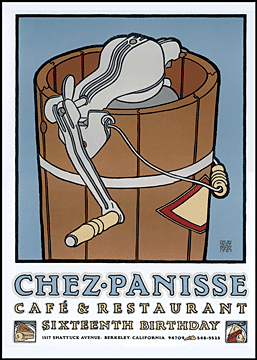
Click on image for detail
(#129) CHEZ PANISSE SIXTEENTH BIRTHDAY:
Edition of 1416 of which 300 copies are signed and numbered 1-300, 26 are signed A-Z as artist's proofs and three sets are signed as progressives.
September 1, 1987 Eight Colors 17" x 24"
Client: Chez Panisse Café & Restaurant, 1517 Shattuck Avenue, Berkeley CA 94709. Telephone (510) 548-5525 A-Z: Artist's own use Progressives: One set to Alice Waters
(Print's Regional Design Annual, 1988)
We humans can instantaneously recognize any combination up to three; after that we have to count, usually by dividing the quantity into smaller parts and then adding the parts together. One stands most particularly for the self: me, I alone. Two is somebody else, and three is a combination of me and somebody else, creating a new One. Indeed, the only English cardinal or ordinal between one and one million that is not Anglo Saxon is the French word Second. The original Anglo Saxon word was Other. Computers, which are not as bright as people, recognize a binary 1 and not-1, or yes and no. Every number is thus expressed uniquely as a power of two. Numbers are written from right to left, and each is double the previous:
65536 32768 16384 8192 4096 2048 1024 512 256 128 64 32 16 8 4 2 1
Thus, the year or number 1987 can be represented as 1024 + 512 + 256 + 128 + 64 + 0 + 0 + 0 + 0 + 2 + 1 = yes yes yes yes yes no no no no yes yes = 111 1100 0011. Since people are unable to speak binary with any fluency, and computers have a lot of trouble with the decimal system, we compromise with a base sixteen, called "hexadecimal," which is 0 through 9 plus the letters A through F, standing for the numbers 10 through 15.
F (15), E (14), D (13), C (12), B (11), A (10), 9 8 7 6 5 4 3 2 1 0
Thus, 1987 in hex is written 7C3 (7 x 162 + 12 x 16 + 3) or (1792 + 192 + 3 = 1987). Because 16 = 24, it is relatively easy to convert hex into binary. To translate to binary: 7 is 111 (yes in the one's place, yes in the two's place and yes in the four's place = 4+2+1=7), C=12 which in binary is 1100, and 3 is 11 in binary (you have to add initial 0's to every number but the first to make a string of 4 digits, so 11 becomes 0011). Add them together and you get a snappy 111 1100 0011. Easy as 0001, 0010, 0011! Computers do not engage like-entities to produce new ones: they rely on us for that. Molly Bloom's breathless "yes I said yes I will Yes," is a consent profoundly different from binary enumeration.* In their hexadecimal celibacy, computers are sweet "10" and never been kissed.
*Molly Bloom's stream-of-consciouness soliloquy brings James Joyce's novel Ulysses to an end.